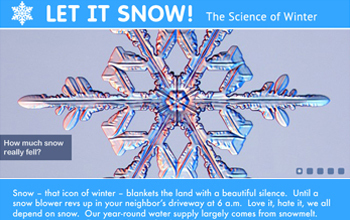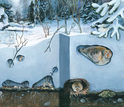News Release 16-005
New NSF special report: Let It Snow! The Science of Winter
Report reveals inner worlds of snow and winter, and their importance to humans and ecosystems

Love it, hate it, we all depend on snow. In many areas, the year-round water supply depends on snow.
January 13, 2016
This material is available primarily for archival purposes. Telephone numbers or other contact information may be out of date; please see current contact information at media contacts.
Snow -- that icon of winter -- blankets the land with a beautiful silence. Love it or hate it, we all depend on snow. Our year-round water supply largely comes from snowmelt.
But we're not the only ones who need snow.
Species from microscopic fungi to 800-pound-moose require it as much, if not more. They survive the winter by living in nature's igloo: snow.
And spring's profusion of flowers? They're fertilized by nutrients in snow.
If you're planning to skate on a frozen lake or river this winter, ski on a snowy slope, or, when spring arrives, depend on snowmelt to fill your reservoir, you may need to think twice.
A view of the new winter
Winter is changing, becoming less like the cold seasons we may remember. The "new winter" has consequences far beyond December-to-March. It affects spring and summer, too, including plants' flowering dates -- and species such as hummingbirds that depend on precision flowering times for nectar.
In celebration of snow and winter as we know it, and in a look at what winter may be like in the future, the National Science Foundation (NSF) has launched a new special report: Let It Snow! The Science of Winter.
The report focuses on projects supported largely by NSF's Directorate for Geosciences and Directorate for Biological Sciences/Division of Environmental Biology.
Grants from these areas fund research on subjects as diverse as measuring snowfall; tracking snowstorm "bombs," as whiteouts are known in meteorology; studying animals and plants that live beneath the snow in an ecosystem called the subnivian; searching for snowmelt, or "white gold"; and the bane of winter -- dust from the atmosphere that causes snow to melt before its time.
Go winter storm-chasing, enter nature's igloo
In the report, explore such topics as winter storm-chasing, a conifer tree's view of snow, life in nature's igloo, and where our winters have gone.
Watch a video of snowflakes photographed by a new high-speed camera, and another on the water that's locked in snow and ice: a zero sum game.
As you look out your window at a snow-covered landscape, or perhaps one that has been so in the past -- and even if you live below the snowline -- find out what scientists are learning about winter.
It matters, even if you never see a snowflake.
-NSF-
-
Can autumn snowfall in Siberia predict winter in the U.S. and Europe? Yes, say researchers.
Credit and Larger Version -
Scientists at NSF's Critical Zone Observatories study snowmelt and water resources.
Credit and Larger Version -
A secret world, unseen by most humans, is alive beneath the surface of winter's snow.
Credit and Larger Version -
The willow ptarmigan is one of many species that use snow as an insulating blanket.
Credit and Larger Version -
How do wood frogs survive being frozen in winter? By living under the snow surface.
Credit and Larger Version
Media Contacts
Cheryl Dybas, NSF, (703) 292-7734, email: cdybas@nsf.gov
The U.S. National Science Foundation propels the nation forward by advancing fundamental research in all fields of science and engineering. NSF supports research and people by providing facilities, instruments and funding to support their ingenuity and sustain the U.S. as a global leader in research and innovation. With a fiscal year 2023 budget of $9.5 billion, NSF funds reach all 50 states through grants to nearly 2,000 colleges, universities and institutions. Each year, NSF receives more than 40,000 competitive proposals and makes about 11,000 new awards. Those awards include support for cooperative research with industry, Arctic and Antarctic research and operations, and U.S. participation in international scientific efforts.
Connect with us online
NSF website: nsf.gov
NSF News: nsf.gov/news
For News Media: nsf.gov/news/newsroom
Statistics: nsf.gov/statistics/
Awards database: nsf.gov/awardsearch/
Follow us on social
Twitter: twitter.com/NSF
Facebook: facebook.com/US.NSF
Instagram: instagram.com/nsfgov







